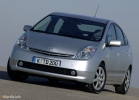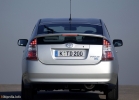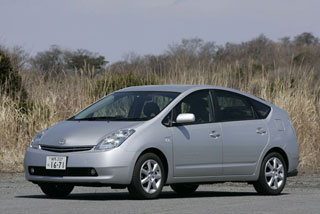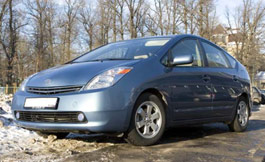Toyota Prius 2006 test drive - 2008 hatchback
Toyota Prius "G Touring Selection, Lather Package",
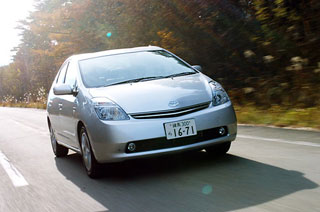 A car with a mixed type of traction (hybrid) that Toyota produces and which is called Prius has undergone a partial update of its model range. During this partial modernization, special attention was paid to the appearance and internal arrangement of the cabin. So, at least, the official point of view sounds. At the same time, there are a number of other innovations that are outwardly invisible. Read about this below.
A car with a mixed type of traction (hybrid) that Toyota produces and which is called Prius has undergone a partial update of its model range. During this partial modernization, special attention was paid to the appearance and internal arrangement of the cabin. So, at least, the official point of view sounds. At the same time, there are a number of other innovations that are outwardly invisible. Read about this below. The car gave an even larger gloss.
As everyone knows, the Toyota Prius model was the first hybrid machine in the history of the Japanese automotive industry. As for his commercial achievements, I will say only one thing: this model in its second generation has become an undoubted leader in sales among all manufactured cars with a mixed type of traction. More than two years ago, the debut of this leader of the leader, so it is not surprising that on November 1, 2005, an official message was held that the Toyota company is moving on to the production of a partially modernized Prius model. According to tradition, which somehow involved in Japan, the main thing that is done during low modernization is an improvement in the appearance, as well as the interior decoration of the cabin, so the difference between the machine before modernization and after, sometimes it is very significant.
So this time, without exception, the employees of our Web CG news agency immediately determined what exactly changed in the Prius car. This is not surprising, given that many of them are used to using this machine almost every day. But on the other hand, it should be recognized: if a person is not the owner, then the very changes in the appearance that I am talking about may well seem so significant. Of course, a new -sample car can be accurately and easily recognized by the Hybrid inscription, which appeared on the front wing. But such a trifle will not be struck by everyone.
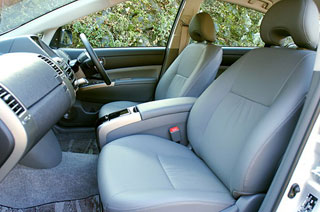 On the other hand, there is something in a new car and something that even an experienced appraiser may not pay attention to. Meanwhile, it is precisely behind these invisible eyes that, in my opinion, the reason is why the new Prius can be called a significant step forward in the development of this model range. In general words, the essence of these changes is that most of the nodes and details were not that changed, but certainly, brought to a higher degree of perfection. At least, we can say for sure that such improvements should please those who have already decided to purchase a Hybrid Prius hybrid, but left this before the appearance of a new model.
On the other hand, there is something in a new car and something that even an experienced appraiser may not pay attention to. Meanwhile, it is precisely behind these invisible eyes that, in my opinion, the reason is why the new Prius can be called a significant step forward in the development of this model range. In general words, the essence of these changes is that most of the nodes and details were not that changed, but certainly, brought to a higher degree of perfection. At least, we can say for sure that such improvements should please those who have already decided to purchase a Hybrid Prius hybrid, but left this before the appearance of a new model. General information about the car.
As you know, the Toyota Prius model has become the world's first serial machine that uses a mixed type of traction. The first modernization of the Prius model range took place in 2003. Speaking more specifically, the second generation car appeared on sale on September 1, 2003. It should be borne in mind that it was starting with this, the second PRIS model, Toyota decided to start its struggle for the corresponding segment of the North America automobile market. For this reason, the second generation car was much larger in size than its predecessor. Plus, to achieve success, the machine was to sharply increase the volume of its luggage compartment. In order for this to become possible, it was decided to abandon the body, the type of which can be determined as a 3-volume (3 Box Body) and take a body of the Hatchback type as a basis.
The power unit is a combination of an internal combustion engine and an electric motor. The gasoline engine has a volume of 1.5 liters, and the maximum power that is developing is 77 horsepower, which, in general, is not so much. As for the power of the electric motor, it, on the contrary, is quite large 68 hp. Due to the special redistribution of the traction force, all the capacity produced is transmitted only to the front wheels, and also goes to the production of electric current, that is, to the generator. The advanced mixed traction system is indicated by the letter combination of Ths-II, it allows you to achieve a very high degree of economy. Suffice it to say that in experimental conditions a new model of a new model was able to pass at one liter of a combustible distance of 35.5 km. It is these data that are indicated in the catalog of the new car. But the point is not only that the car began to consume even less fuel. It is also pleasing that the developed power of the electric motor became higher, which made it possible to actually equate this car hybrid with the 2-liter class of ordinary machines.
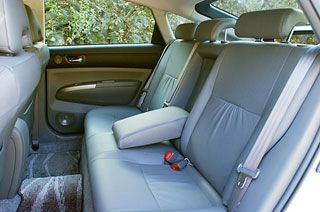 All of the above applies to the second generation car as a whole. However, as already noted, in November 2005 there was a partial update of the Prius model range, during which the main attention was paid to improving the appearance and internal arrangement of the salon. If we talk about the changes in the appearance, then it should be noted not only the new decorative grille of the radiator and the new configuration of the front headlights, but also the fact that the rear window is now equipped with a wiper. As for the interior of the cabin, a new soft material is immediately striking, which covers the front panel, as well as the internal door cladding along with the dodgers. What else? The on-board navigator, which operated as part of the system of guidelines called Toyota Car Telematic Service, now has a wider range of application due to access to the G-Book Alpha network.
All of the above applies to the second generation car as a whole. However, as already noted, in November 2005 there was a partial update of the Prius model range, during which the main attention was paid to improving the appearance and internal arrangement of the salon. If we talk about the changes in the appearance, then it should be noted not only the new decorative grille of the radiator and the new configuration of the front headlights, but also the fact that the rear window is now equipped with a wiper. As for the interior of the cabin, a new soft material is immediately striking, which covers the front panel, as well as the internal door cladding along with the dodgers. What else? The on-board navigator, which operated as part of the system of guidelines called Toyota Car Telematic Service, now has a wider range of application due to access to the G-Book Alpha network. The Prius machine of the new model has two categories S (basic) and more comfortable G. Category G, on which the testing trip was performed, had a special suspension setting and was equipped with 16-inch wheels. This option is called in the catalog as a Touring Selection. In addition, it should be noted that the vehicle tested had an interior of genuine leather, which is included in the standard equipment. In addition, the standard set of equipment of this machine included the Intelligent Parking Assist system, SRS side pneumatic pneumatic pillows (on the front seats), and SRS pods such as a curtain in the rear seats.
Salon volume and the capacity of the luggage compartment.
The dashboard is formed by the Center Meter type, so the driver has the opportunity to monitor the instruments without taking his eyes off the road. If earlier all experts noted that the qualitative perception of this section of the front panel leaves much to be desired, then the panel has been improved in the new car, since it was decided to cover with a soft material with corrugation. Now she makes a great impression.
 This is what. The car on which I performed a test trip, that is, a modification of G Touring Selection Lather Package, is considered a car of the highest category. I will list what it was in its standard equipment. So, these are xenon headlights, the HDD navigation system. By the way, the on -board navigator came with the JBL Premium audio system (option). Further, the standard SRS airbags and curtain type pillows are also included in the standard set. These two types of pneumatic airbags for other modifications are placed only in the option of the option, for which another 63 thousand yen will be additionally taken from the buyer. The exception is only the basic modification of S Standard Package, where these protective equipment cannot be established in principle due to its design features. In this regard, the question is: is it time for Toyota to move from words to business, that is, to the policy of total equipment of its models with the most advanced means of ensuring the safety of passengers and the driver, including the S-VSC system, which deciphens as Steering Assisted Vehicle Stability Control? And then everyone only says that all machines, regardless of categories, should be equipped with the same protective equipment, and as it comes to business, there are a lot of reasons not to do this!
This is what. The car on which I performed a test trip, that is, a modification of G Touring Selection Lather Package, is considered a car of the highest category. I will list what it was in its standard equipment. So, these are xenon headlights, the HDD navigation system. By the way, the on -board navigator came with the JBL Premium audio system (option). Further, the standard SRS airbags and curtain type pillows are also included in the standard set. These two types of pneumatic airbags for other modifications are placed only in the option of the option, for which another 63 thousand yen will be additionally taken from the buyer. The exception is only the basic modification of S Standard Package, where these protective equipment cannot be established in principle due to its design features. In this regard, the question is: is it time for Toyota to move from words to business, that is, to the policy of total equipment of its models with the most advanced means of ensuring the safety of passengers and the driver, including the S-VSC system, which deciphens as Steering Assisted Vehicle Stability Control? And then everyone only says that all machines, regardless of categories, should be equipped with the same protective equipment, and as it comes to business, there are a lot of reasons not to do this! As you might guess from the name of the category of the machine on which I made a test trip - G Touring Selection Lather Package - the seats installed in the cabin have a leather upholstery. Along the way, I note that the steering wheel is also dressed in a leather cover, but this is a common moment for all cars of category G. It is clear that the leather coating of the front seats visually makes the interior above the class. Despite the fact that the seats are rather hard, the backs of the seats, on the contrary, are soft. Unfortunately, it may be because of my complexion, but I was not satisfied with how supporting calipers on the back of the chair are located and how they covered my lower back. Therefore, I personally believe that it would be appropriate to make the back of a driver's seat with an adjustable bend.
 The steering wheel is divided into 4 sectors, on it you can see the control keys for the navigation system, an audio system and air conditioning. I personally like the steering wheel to be a steering wheel, without any details there, which are not directly related to driving. Although on the other hand, it is convenient when it is possible, without looking up from the road, adjust the temperature of the air supplied to the salon. Therefore, as for the air conditioning control key, I am more for than against.
The steering wheel is divided into 4 sectors, on it you can see the control keys for the navigation system, an audio system and air conditioning. I personally like the steering wheel to be a steering wheel, without any details there, which are not directly related to driving. Although on the other hand, it is convenient when it is possible, without looking up from the road, adjust the temperature of the air supplied to the salon. Therefore, as for the air conditioning control key, I am more for than against. The rear seats cannot boast of any special advantages, but the fact that they turned out to be much more spacious than it can be assumed, looking at the body outside, deserves a high rating. If the passenger just sits in a normal position, then nothing interferes with his feet, moreover, free space still remains between his knees and the back of the front chair, and since the body of the car is made like a hatchback, then nothing interferes with the head of the seated one. The leather tightening of the seats was made efficiently, so I even wanted to spend more time there, back than driving. Seats are equipped with a armrest in the middle and a stand for cans or bottles.
Compared to what was in the previous model, the trunk, of course, became more practical, because, as already noted, the car body was taken from the hatchback. It is impossible not to discount the design of the rear seats in this regard, thanks to which the left and right parts can change their position independently of each other. So, in principle, the trunk deserves even 5 points. But at the same time, the height of the trunk may seem insufficient to someone, so I decided to throw off one score and put the four.
The floor of the luggage compartment is almost at the same level with the upper edge of the rear bumper, the floor itself is even throughout the area. If the volume is not enough, you can increase spaciousness due to changes in the position of the rear seats. We should not forget that under the floor there is an additional baggage niche. All this in itself is already quite good, and when you consider that we are talking about the car with a hybrid with all the impacts of the layout of the layout, then what to talk about, four points, not lower!
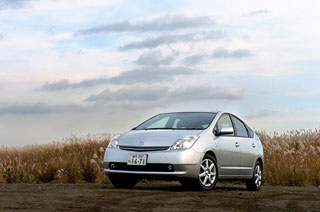 What is the car on the go?
What is the car on the go? Both to low modernization, and after it, the Prius car is equipped with a Ths-II power system, which is already so famous that it does not require any special recommendations. I’ll just list its advantages again: thanks to the good compatibility of the internal combustion engine and the electric motor, the machine began to consume even less fuel, and, accordingly, became more safe for the ecology. At the initial moment of movement, the total power is, like a simple car of a 2-type class. And if you just move out of the car, the intensity of its acceleration no longer depends on what the machine has the initial speed. By this, I want to emphasize that the torque that arises when pressing the accelerator is quite sufficient to give it the necessary acceleration at any time. Of course, with intensive acceleration, the noise from the working engine is also rather big. But you just have to switch to constant speed, as the noise level will become more than acceptable. And one moment. It is due to the fact that in this car, the gas pedal does not have a direct message either with the internal combustion engine, or with an electric motor, but controls them, as they say, at the same time. And this undoubtedly spoils the pleasure of the driver. But on the other hand, if receiving such pleasure is not an end in itself for the driver (there are other types of cars for this), then he must appreciate the high level of consistency of the two components of the power block, which takes place in the second -generation Prius car.
Nothing is said about the changes in the steering in the catalog, although in fact they are, there may be even the most significant of all that appeared in the car after partial modernization.
The car I controlled was equipped with 195/55/r16 tires. They turned out to be quite tough and often could not cut off all the tubercles and potholes that met in the way. However, at the same time, strong shocks, which often cause a feeling of discomfort, did not experience the body. This indicates that the machine has become, so to speak, more stable.
When I overcame the joints of the road surface at high speed, the suspension could not completely crush characteristic and inevitable shocks, but in everything else, as for the car’s behavior when driving at high speed in a straight line, it only remained to rejoice. The steering, which, as you know, has an electric amplifier, is characterized by a rather high degree of consistency, although some unnaturalness, compared to the steering wheel working on hydraulics, continues to make itself felt. This is not to say that the steering wheel drives the machine too sharply, although on the other hand, we are talking about a car that claims to become a type of the so -called family machine. And by the standards of cars of this group, controllability is at a very satisfactory level.
Technical characteristics of the Toyota Prius G Touring Selection Lather Package:
Length 4445 mm x width 1725 mm x height 1490 mm.
Wheel base: 2700 mm.
Machine weight: 1310 kg.
Drive: on the front wheels
Internal combustion engine: 1.5- liter, 4-cylinder, developed power 77 hp. at 5000 rpm, maximum torque 11.7 kg/m at 4200 rpm.
Electricians: power 68 hp/1200 ~ 1540 vol./Min., Torque of 40.8 kg/m,
0 ~ 1200 vol./Min.
The basic price of the car: 3 million 255 thousand yen.
The price of the car on which the test trip was performed: 3 million 399.9 thousand yen.
List of options included in the complete set of the machine:
- HDD navigation system with a JBL Premium audio system 121.8 thousand yen; An additional set for driving by cold 23.1 thousand yen.
The purpose of the tests: obtaining a general idea of \u200b\u200bthe behavior of the machine on the go
Place of tests: City line (3) Highway (6) Mountain Road (1).
Mileage during testing: 397.8 km
Actual fuel consumption: 21.1 liters
Average fuel consumption: one liter for every 18.9 km of path
Source: Webcg.net
Toyota Prius 2006 Crash Video - 2008
Toyota Prius 2006 test drives - 2008
Toyota Prius 2006 malfunctions - 2008
Toyota prius: Detailed information| Prius 2006 - 2008 | |
|---|---|
| Engine |  |
| Transmission |  |
| Control system and suspension |  |
| Brake system |  |
| Air heating and air conditioning |  |
| Launch and charging system |  |
| Electric components and so on |  |
| Corrosion body stability |




